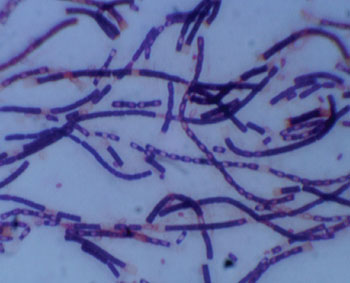New Method Identifies Anthrax Bacteria Faster Than Current Approaches
By LabMedica International staff writers
Posted on 06 Mar 2014
A new method has been developed for rapid diagnostic detection and antibiotic susceptibility determination of the pathogenic Bacillus anthracis using a bioluminescent reporter phage.Posted on 06 Mar 2014
Although anthrax is a treatable disease, positive patient prognosis is dependent on rapid diagnosis and therapy. A team at the University of Missouri (MU; Columbia, MO, USA) assessed a bioluminescent reporter phage, developed by David Schofield at Guild BioSciences (Charleston, SC, USA), for its value as a clinical diagnostic tool for Bacillus anthracis. The reporter phage based method, published in the Journal of Microbiological Methods (November 2013), detects live B. anthracis strains by transducing a bioluminescent phenotype. It was found to rule out false positives – displaying species specificity by its inability, or significantly reduced ability, to detect members of the closely related Bacillus cereus group and other common bacterial pathogens.

Caption: The anthrax bacteria – Bacillus anthracis, transmitted mainly through inhalation or skin abrasions (Photo courtesy of University of Missouri).
The method detects low levels of B. anthracis, at clinically relevant bacterial concentrations, within 5 hours. “Normally to identify whether an organism is present, you have to extract the material, culture it, and then pick colonies to examine that might turn out to be anthrax bacteria,” said Prof. George Stewart, PhD, medical bacteriologist. “Then you conduct chemical testing which takes some time—a minimum of 24 to 48 hours. Using this newly-identified method, we can reduce that time to about 5 hours.” The method also provides antibiotic susceptibility information that mirrors the CLSI method, except that data are obtained at least 5-fold faster.
In addition to saving lives, the new method could also save on high clean up and decontamination costs of bioterrorism attacks. These costs for the post-9/11 2001 anthrax letters attack totaled USD 3.2 million, according to a 2012 report. “In the years since the post-9/11 postal attacks, we haven’t had any bona fide anthrax attacks,” said Prof. Stewart; “That doesn’t mean that it’s not going to happen, we just have to be prepared.” Current methods take 1–3 days to produce definitive results for anthrax. The new detection method would potentially alert of a negative result 5 hours into clean-up efforts instead of 1–3 days into expensive decontamination.
Related Links:
University of Missouri at Columbia
Guild Biosciences




 assay.jpg)








